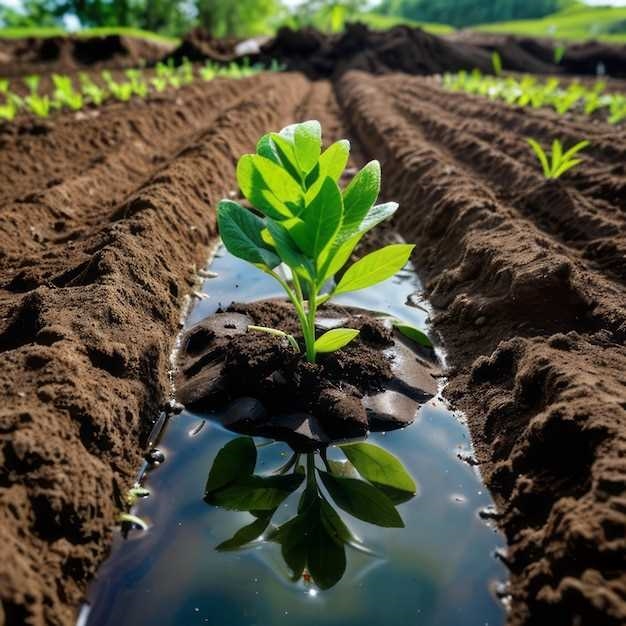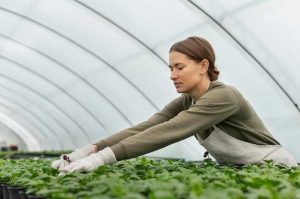

In today’s rapidly changing world, there is an increasing need to find innovative solutions to address the pressing environmental challenges we face. One such solution lies in the realm of agriculture, where a paradigm shift towards a more holistic and regenerative approach is gaining momentum. By focusing on the interconnectedness of soil, ecosystems, and biodiversity, we have the potential to restore the health and vitality of our planet for long-term sustainability.
At the heart of this transformative approach is the recognition that our soil is not merely a medium for growing crops, but a living ecosystem teeming with life and potential. By nurturing and replenishing the soil, we can unlock its inherent capacity to support diverse and resilient plant life, while also sequestering carbon and mitigating climate change. This regenerative approach goes beyond conventional farming practices, which often rely on synthetic inputs and chemical interventions that degrade the soil and harm biodiversity.
By adopting regenerative agricultural practices, we can cultivate a harmonious relationship between humans and nature, where the health of the soil and the well-being of ecosystems are prioritized. This approach emphasizes the use of organic and natural methods, such as cover cropping, crop rotation, and composting, to enhance soil fertility and structure. By building healthy soils, we can improve water retention, reduce erosion, and enhance nutrient cycling, creating a resilient and sustainable agricultural system.
Furthermore, regenerative agriculture recognizes the importance of biodiversity in maintaining the overall health and resilience of ecosystems. By promoting the presence of diverse plant and animal species, we can create a balanced and thriving ecosystem that is better equipped to withstand environmental challenges. This approach not only benefits farmers by reducing the reliance on external inputs, but also contributes to the preservation of endangered species and the protection of natural habitats.
As we strive towards a more sustainable future, regenerative agriculture offers a promising pathway to restore the vitality of our planet. By nurturing the soil, enhancing biodiversity, and embracing holistic practices, we can create a resilient and thriving agricultural system that supports both human livelihoods and the health of our planet. It is time to embark on this transformative journey towards regenerative agriculture, where the potential for long-term sustainability lies.
Understanding Regenerative Agriculture: A Holistic Approach to Farming

In the realm of sustainable farming practices, there exists a comprehensive and interconnected approach known as regenerative agriculture. This innovative method goes beyond the conventional understanding of farming, focusing on the restoration and enhancement of the natural elements that contribute to the overall health and vitality of the land. By adopting regenerative agriculture, farmers aim to cultivate a harmonious relationship between the environment, biodiversity, and long-term agricultural sustainability.
At its core, regenerative agriculture recognizes the intricate web of life that exists within and around agricultural systems. It acknowledges the importance of nurturing and revitalizing the soil, acknowledging it as a living organism that serves as the foundation for all agricultural endeavors. By employing regenerative practices, farmers prioritize the enhancement of soil health, utilizing techniques that promote organic matter accumulation, minimize erosion, and foster nutrient cycling.
Furthermore, regenerative agriculture embraces the concept of biodiversity as a key component of sustainable farming. By encouraging the coexistence of various plant and animal species, farmers create a balanced ecosystem that supports natural pest control, pollination, and nutrient cycling. This holistic approach not only enhances the resilience of the agricultural system but also contributes to the preservation of native flora and fauna.
Regenerative agriculture also emphasizes the importance of long-term sustainability. By implementing practices that minimize the use of synthetic inputs and reduce reliance on external resources, farmers can create self-sufficient systems that are resilient to external shocks. This approach promotes the efficient use of water, energy, and other resources, ensuring their availability for future generations.
In conclusion, regenerative agriculture represents a holistic and forward-thinking approach to farming. By prioritizing the restoration of soil health, the promotion of biodiversity, and the pursuit of long-term sustainability, farmers can create resilient and thriving agricultural systems that benefit both the environment and society as a whole.
The Importance of Soil Health: Enhancing Nutrient Cycling and Water Retention
Soil health plays a crucial role in sustaining the long-term productivity and resilience of agricultural systems. It encompasses various factors that contribute to the overall well-being of the soil, including its ability to cycle nutrients efficiently and retain water effectively. Understanding the importance of soil health is essential for promoting sustainable agricultural practices and ensuring the future viability of our food production systems.
Enhancing Nutrient Cycling
One of the key aspects of soil health is its ability to cycle nutrients. Nutrient cycling refers to the process by which essential elements, such as nitrogen, phosphorus, and potassium, are taken up by plants, returned to the soil through organic matter decomposition, and made available for future plant uptake. A healthy soil ecosystem facilitates this cycling by providing a diverse community of microorganisms, including bacteria, fungi, and earthworms, that break down organic matter and release nutrients in forms that plants can readily utilize.
By enhancing nutrient cycling, farmers can reduce their reliance on synthetic fertilizers, which can have detrimental effects on the environment and human health. Healthy soils with robust nutrient cycling capabilities can naturally supply plants with the necessary nutrients, reducing the need for external inputs. This not only reduces the environmental impact of agriculture but also promotes the long-term sustainability of farming systems.
Water Retention
Another critical aspect of soil health is its ability to retain water. Water retention refers to the capacity of the soil to hold moisture, preventing excessive runoff and promoting infiltration. Healthy soils with good water retention capabilities can help mitigate the impacts of drought and improve overall water-use efficiency in agricultural systems.
Improving water retention in soils is particularly important in the face of climate change, as extreme weather events, including droughts and heavy rainfall, become more frequent. Soils with enhanced water retention can store water during wet periods, reducing the risk of flooding, and release it gradually during dry periods, providing a consistent water supply to plants. This not only improves crop resilience but also contributes to water conservation efforts and reduces the need for irrigation.
In conclusion, recognizing the importance of soil health in enhancing nutrient cycling and water retention is crucial for promoting sustainable agricultural practices. By prioritizing soil health, farmers can reduce their reliance on synthetic inputs, improve crop resilience, and contribute to the long-term sustainability of our food production systems.
Restoring Biodiversity: Promoting Natural Pest Control and Pollination
In the pursuit of sustainable agricultural practices, it is crucial to focus on restoring biodiversity within ecosystems. By promoting natural pest control and pollination, we can create a harmonious balance that benefits both the environment and agricultural productivity.
Enhancing Natural Pest Control
One of the key aspects of restoring biodiversity is the promotion of natural pest control methods. Instead of relying solely on chemical pesticides, which can have detrimental effects on the environment, we can encourage the presence of natural predators and beneficial insects. These organisms play a vital role in keeping pest populations in check, reducing the need for harmful chemicals and promoting a healthier ecosystem.
Integrated pest management (IPM) techniques can be employed to minimize the use of pesticides and maximize the effectiveness of natural pest control. This approach involves monitoring pest populations, implementing cultural practices to discourage pests, and utilizing biological controls such as introducing predator species or using pheromones to disrupt mating patterns.
Promoting Pollination
Pollinators, such as bees, butterflies, and birds, are essential for the reproduction of many plant species, including crops. However, habitat loss, pesticide use, and other factors have led to a decline in pollinator populations. To restore biodiversity and ensure successful pollination, it is crucial to create suitable habitats and provide resources for these important creatures.
Planting diverse flowering plants that bloom at different times throughout the year can provide a continuous food source for pollinators. Additionally, creating nesting sites and maintaining undisturbed areas can offer shelter and protection for pollinators to thrive. By promoting pollination, we not only support the reproduction of plants but also enhance the overall biodiversity and resilience of ecosystems.
In conclusion, restoring biodiversity through the promotion of natural pest control and pollination is essential for long-term sustainability in agriculture. By reducing reliance on harmful pesticides and creating suitable habitats for beneficial organisms, we can foster a healthier environment and ensure the continued productivity of our agricultural systems.
Carbon Sequestration: Mitigating Climate Change through Regenerative Practices
In the context of the broader theme of regenerative agriculture, this section focuses on the crucial role of carbon sequestration in mitigating climate change. By employing regenerative practices, we can actively contribute to reducing greenhouse gas emissions and restoring the balance of our planet’s climate system. This section explores the various methods and techniques that can be utilized to enhance carbon sequestration, highlighting their importance in achieving long-term sustainability and resilience.
The Significance of Carbon Sequestration
Carbon sequestration refers to the process of capturing and storing carbon dioxide from the atmosphere, preventing it from contributing to the greenhouse effect and climate change. It plays a vital role in mitigating the impacts of global warming by reducing the concentration of greenhouse gases in the atmosphere. Through regenerative practices, we can enhance the natural capacity of ecosystems to sequester carbon, thereby helping to stabilize the climate and create a more sustainable future.
Methods for Enhancing Carbon Sequestration

There are various methods and practices that can be employed to enhance carbon sequestration in agricultural and natural systems. These include the adoption of agroforestry techniques, which involve integrating trees into agricultural landscapes to increase carbon storage and biodiversity. Additionally, the implementation of cover cropping and rotational grazing can improve soil health and promote carbon sequestration. Furthermore, the restoration of degraded ecosystems, such as wetlands and forests, can significantly contribute to carbon sequestration efforts.
| Method | Description |
|---|---|
| Agroforestry | Integrating trees into agricultural landscapes to enhance carbon storage and biodiversity. |
| Cover cropping | Planting cover crops during fallow periods to improve soil health and sequester carbon. |
| Rotational grazing | Rotating livestock across different pastures to promote soil health and increase carbon sequestration. |
| Ecosystem restoration | Restoring degraded ecosystems, such as wetlands and forests, to enhance carbon sequestration and biodiversity. |
By implementing these regenerative practices and actively focusing on carbon sequestration, we can contribute to mitigating climate change and ensuring a sustainable future for generations to come. The combination of these methods can help restore the balance of our ecosystems, enhance soil health, and promote biodiversity, all while reducing the concentration of greenhouse gases in the atmosphere.
Economic Benefits of Regenerative Agriculture: Improving Farm Profitability and Resilience
Enhancing the economic viability of farming operations is a crucial aspect of regenerative agriculture. By implementing sustainable practices that prioritize soil health and biodiversity, farmers can improve their profitability and build resilience against various challenges. This section explores the economic benefits associated with regenerative agriculture and highlights how it can contribute to the long-term success of farming enterprises.
1. Increased Yield and Quality
One of the key economic advantages of regenerative agriculture is the potential for increased crop yield and improved product quality. By focusing on soil health and biodiversity, farmers can create an environment that supports optimal plant growth and nutrient uptake. This can result in higher yields and enhanced market value for their produce, leading to increased profitability.
2. Reduced Input Costs
Regenerative agriculture practices often involve minimizing the use of synthetic fertilizers, pesticides, and other costly inputs. Instead, farmers rely on natural processes and techniques such as cover cropping, crop rotation, and integrated pest management. By reducing the reliance on expensive inputs, farmers can significantly lower their production costs, thereby improving their overall profitability.
| Benefits | Description |
|---|---|
| Improved Soil Health | Regenerative agriculture practices help restore soil fertility, structure, and nutrient content, leading to healthier and more productive soils. |
| Enhanced Water Management | By improving soil structure and organic matter content, regenerative agriculture helps increase water infiltration and retention, reducing the need for irrigation and improving drought resilience. |
| Enhanced Biodiversity | Regenerative agriculture promotes the preservation and restoration of diverse ecosystems, which can lead to improved pest control, pollination, and overall ecosystem resilience. |
| Climate Change Mitigation | Through carbon sequestration in the soil, regenerative agriculture can help mitigate climate change by reducing greenhouse gas emissions and enhancing carbon storage. |
Overall, the economic benefits of regenerative agriculture extend beyond immediate profitability. By improving farm productivity, reducing input costs, and promoting long-term sustainability, regenerative practices can contribute to the resilience and success of farming operations in the face of evolving environmental and economic challenges.
Transitioning to Regenerative Agriculture: Challenges and Opportunities for Farmers
As farmers embark on the journey towards adopting regenerative practices, they are faced with a multitude of challenges and opportunities. This transition requires a shift in mindset and a willingness to embrace new approaches to farming. Farmers must navigate through various obstacles while also recognizing the potential benefits that regenerative agriculture can bring to their operations.
One of the main challenges farmers face when transitioning to regenerative agriculture is the need to break away from conventional farming methods. This involves moving away from the reliance on synthetic inputs such as chemical fertilizers and pesticides, and instead focusing on natural and sustainable alternatives. This shift requires a deep understanding of soil health and the importance of biodiversity in promoting long-term sustainability.
Another challenge lies in the financial aspect of transitioning to regenerative agriculture. Farmers may initially face higher upfront costs as they invest in new equipment, infrastructure, and training. However, it is important to recognize the potential long-term financial benefits that regenerative practices can bring. By improving soil health and reducing input costs, farmers can achieve greater productivity and profitability in the long run.
Furthermore, transitioning to regenerative agriculture requires a significant amount of knowledge and education. Farmers need to learn about the principles and techniques of regenerative farming, as well as the specific needs of their land and crops. This may involve attending workshops, collaborating with experts, and experimenting with different approaches. It is a continuous learning process that requires patience and dedication.
Despite the challenges, there are also numerous opportunities for farmers in transitioning to regenerative agriculture. By adopting regenerative practices, farmers can improve the overall health and resilience of their soil, leading to increased crop yields and reduced vulnerability to pests and diseases. Additionally, regenerative agriculture can contribute to mitigating climate change by sequestering carbon in the soil and reducing greenhouse gas emissions.
Moreover, transitioning to regenerative agriculture allows farmers to reconnect with nature and foster a deeper appreciation for the environment. By working in harmony with the natural ecosystem, farmers can create a more sustainable and biodiverse landscape that supports not only their own livelihoods but also the health and well-being of future generations.
- Breaking away from conventional farming methods
- Financial challenges and long-term benefits
- Knowledge and education requirements
- Improved soil health and resilience
- Contribution to mitigating climate change
- Reconnecting with nature and fostering biodiversity





